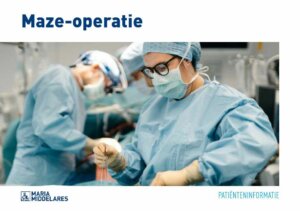Maze procedure
What is it?
What is it?A Maze procedure is a treatment for atrial fibrillation and atrial flutter. If medication, cardioversion and ablation are not effective or if other heart surgery (bypass and/or valve repair or valve replacement) is necessary and atrial fibrillation is present, a Maze procedure is opted for.
For a Maze procedure, the physician applies heat (usually with radiofrequency) or cold to form scar lines in the atrium. This divides the heart tissue into strips. These strips are connected to each other and to the valves or openings in the heart so that the signal cannot circle back but continues its path. This produces amaze pattern and rhythm disorders can no longer occur. There is no change to the origin of the electrical signals.
What is the process?
What is the process?The Maze procedure extends a valve replacement procedure or bypass operation by approximately 30 minutes.
Because the heart is stopped during the operation, the heart rhythm is often slow or conduction is interrupted. Before the chest is closed, electrodes (thin metal wires) are attached to the heart. This is always done as a precaution. If the heart were to have a slow heartbeat after the procedure, an external pacemaker can be connected to these electrodes. The wires are removed just before your discharge from the hospital.
Results
ResultsFibrillation may recur after the operation and may sometimes recur in the form of episodes for weeks or months afterwards. This is because the atrial tissue needs to heal after the surgery. It is important that any atrial fibrillation after the surgery is regarded as a new rhythm disorder and treated aggressively. Therefore, the final result can only be assessed after about six months.
Atrial fibrillation often occurs after heart surgery, even if it was not observed before the operation.
Leaflet
LeafletMore information about the heart, atrial fibrillation and the course of the procedure can be found in the leaflet below.
Only available in Dutch:

Maze-operatie
DownloadCentres and specialist areas
Centres and specialist areas
Something wrong or unclear on this page? Report it.
Latest publication date: 13/08/2024





